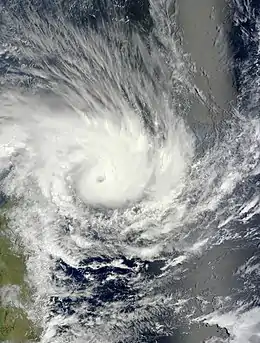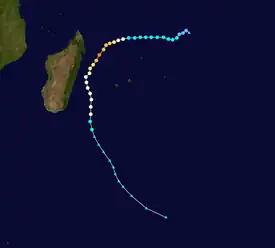| Intense tropical cyclone (SWIO scale) | |
|---|---|
| Category 4 tropical cyclone (SSHWS) | |
 Intense Tropical Cyclone Felleng on 30 January 2013 | |
| Formed | 25 January 2013 |
| Dissipated | 3 February 2013 |
| Highest winds | 10-minute sustained: 175 km/h (110 mph) 1-minute sustained: 215 km/h (130 mph) |
| Lowest pressure | 935 hPa (mbar); 27.61 inHg |
| Fatalities | 18 |
| Damage | > $10 million (2013 USD) |
| Areas affected | Seychelles, Madagascar, and Réunion |
| Part of the 2012–13 South-West Indian Ocean cyclone season | |
Intense Tropical Cyclone Felleng was a powerful tropical cyclone that caused destruction across Seychelles, Madagascar, and Réunion. The seventh Tropical Disturbance, sixth named storm, and the third Intense Tropical Cyclone of the 2012–13 South-West Indian Ocean cyclone season, Felleng originated from an area of atmospheric convection embedded in the Intertropical Convergence Zone.
In total, Felleng caused 18 fatalities and above US$10 million in damages.[1]
Meteorological history

Tropical storm (39–73 mph, 63–118 km/h)
Category 1 (74–95 mph, 119–153 km/h)
Category 2 (96–110 mph, 154–177 km/h)
Category 3 (111–129 mph, 178–208 km/h)
Category 4 (130–156 mph, 209–251 km/h)
Category 5 (≥157 mph, ≥252 km/h)
Unknown
After the Madden–Julian oscillation left its suppressive phase in the South-West Indian Ocean, a low-pressure area embedded in the Intertropical Convergence Zone was noted by Météo-France La Réunion (MFR) on 24 January.[2] Convection was mainly active in the northeast portion of the system, with winds reaching 45 km/h (30 mph) in some places.[3] The system's low-level circulation was poorly defined by 25 January,[4] with the system as a whole being negatively affected by wind shear.[2] At 18:00 Coordinated Universal Time (UTC), MFR upgraded the system to Tropical Disturbance 7,[5] with the Joint Typhoon Warning Center (JTWC) upgrading it to a tropical depression at the same time, assigning it the designation 13S.[6] A small central dense overcast formed[7] as gale-force winds appeared in system's western half,[8] and on 26 January at 06:00 UTC, MFR upgraded Tropical Disturbance 7 to a tropical depression.[5] Weakening wind shear allowed convection to further organize;[9] however, it decayed later in the day, partially exposing the system's low-level circulation.[2] By 12:00 UTC, the JTWC upgraded 7 to a tropical storm.[6] The system's structure improved from its previous sheared pattern,[2] and by 28 January, the MFR upgraded the system to a moderate tropical storm, assigning it the name Felleng.[5]
Felleng improved over the next few hours, consolidating its low-level circulation[10] as its wind field became more symmetrical.[11] Steadily intensifying, it reached Intense Tropical Cyclone strength on 30 January while developing a well-defined eye, with a deep, intense ring of convective banding forming in the eyewall.[12] On 31 January the eye became less well defined, and started to collapse.[13] On 1 February the system started to become elongated, and weakened into a severe tropical storm as it began its extratropical transition.[14] By 3 February, Felleng became fully extratropical, with the low level circulation center becoming totally exposed and elongated, under vertical wind shear, located to the west of the remnant convection.[15]
Impact
Seychelles
Cyclone Felleng devastated the islands of Mahe, Praslin, and La Digue as a depression, many types of buildings were damaged and many farms were wiped out. Around 1,000 families were affected by floods and landslides, 246 of them were registered as displaced after their homes were damaged or destroyed.[16][17][18] Damages from Felleng reached US$8.4 million in the country.[19]
Madagascar
Cyclone Felleng brought heavy rain to Madagascar, due to which floodwaters rose rapidly in the capital Antananarivo, flooding many low-lying homes, as well as several hundred hectares of rice fields. Government authorities confirmed at least 800 people have been affected by the floods in the capital.[20][21] Across the island, 9 people were killed and 1,303 were left homeless. A total of 162 homes were destroyed while another 1,803 were damaged by floodwaters, most of which were in Vatovavy-Fitovinany.[22]
Réunion
Cyclone Felleng's heavy rain and strong winds caused damage in Réunion Island, where 11,200 homes were left without power.[23] Over the course of 72-hours, up to 800 mm (31 in) of rain fell in parts of the island, resulting in significant flooding. In Plaine des Cafres, 512 mm (20.2 in) fell within 24‑hours.[24]
See also
References
- ↑ February 2013 Global Catastrophe Recap (PDF) (Report). Aon Benfield. 6 March 2013. p. 6. Archived from the original (PDF) on 2 December 2018.
- 1 2 3 4 Bientz, Catherine; Boudart, Géraldine; Dupont, Thierry; Langlade, Sébastien; Quetelard, Hubert (November 2014). Saison Cyclonique Sud-Ouest de l'océan Indien 2012 - 2013 [Cyclone Season South-West Indian Ocean 2012 - 2013] (PDF) (Report) (in French and English). Météo-France La Réunion. ISSN 2119-6818. Retrieved 13 August 2021.
- ↑ "Bulletin for Cyclone Activity and Significant Tropical Weather in the Southwest Indian Ocean 2013/01/24 at 12:00 UTC" (PDF). Météo-France La Réunion. 24 January 2013. Archived (PDF) from the original on 2021-08-13. Retrieved 13 August 2021.
- ↑ "Bulletin for Cyclone Activity and Significant Tropical Weather in the Southwest Indian Ocean 2013/01/25 at 12:00 UTC" (PDF). Météo-France La Réunion. 25 January 2013. Archived (PDF) from the original on 2021-08-13. Retrieved 13 August 2021.
- 1 2 3 "Felleng: 25 January 2013 TO 2013-02-05". Météo-France La Réunion. Archived from the original on 2021-08-13. Retrieved 13 August 2021.
- 1 2 "2013 Southern Hemisphere Best Track Data". Joint Typhoon Warning Center. Retrieved 13 August 2021.
- ↑ "Significant Tropical Weather Advisory for the Indian Ocean from 260300Z-261800Z January 2013". Joint Typhoon Warning Center. 26 January 2013. Archived from the original on 3 December 2013. Retrieved 13 August 2021.
- ↑ "Tropical Cyclone Forecast Warning 1 for Tropical Depression 7" (PDF). Météo-France La Réunion. 25 January 2013. Archived (PDF) from the original on 2021-08-13. Retrieved 13 August 2021.
- ↑ "Tropical Cyclone Forecast Warning 2 for Tropical Depression 7" (PDF). Météo-France La Réunion. 26 January 2013. Archived (PDF) from the original on 2021-08-22. Retrieved 22 August 2021.
- ↑ "Tropical Cyclone Forecast Warning 9 for Moderate Tropical Storm 7 (Felleng)" (PDF). Météo-France La Réunion. 28 January 2013. Archived (PDF) from the original on 2021-08-22. Retrieved 22 August 2021.
- ↑ "Tropical Cyclone Forecast Warning 10 for Moderate Tropical Storm 7 (Felleng)" (PDF). Météo-France La Réunion. 28 January 2013. Archived (PDF) from the original on 2021-08-22. Retrieved 22 August 2021.
- ↑ "Tropical Cyclone Forecast Warning 17". RSMC La Réunion. Archived from the original on 30 January 2013. Retrieved 2 February 2013.
- ↑ "WebCite query result". www.webcitation.org. Archived from the original on 2013-01-31. Retrieved 13 August 2021.
{{cite web}}: Cite uses generic title (help) - ↑ "WebCite query result". www.webcitation.org. Archived from the original on 2013-02-02. Retrieved 13 August 2021.
{{cite web}}: Cite uses generic title (help) - ↑ "WebCite query result". www.webcitation.org. Archived from the original on 2013-02-04. Retrieved 13 August 2021.
{{cite web}}: Cite uses generic title (help) - ↑ "Tropical Cyclone Felleng - Jan 2013". ReliefWeb. 13 March 2015. Retrieved 13 August 2021.
- ↑ "Seychelles: Damage, Loss and Needs Assessment | GFDRR". www.gfdrr.org. Retrieved 13 August 2021.
- ↑ https://documents1.worldbank.org/curated/en/689161468106741988/pdf/788140WP0Box370A0June0201300PUBLIC0.pdf
- ↑ "Stories of Impact: Weathering Future Storms in Seychelles" (PDF). Global Facility for Disaster Reduction and Recovery. 5 March 2015. p. 2. Archived from the original (PDF) on 21 March 2015. Retrieved 16 August 2021.
- ↑ "Six killed, three missing in Madagascar cyclone". GlobalPost. Retrieved 19 November 2015.
- ↑ Madagascar – Felleng fait six morts et trois disparus (Lexpress.mu)
- ↑ Vonjy Radasimalala (5 February 2013). "Cyclone Felleng: Neuf décès et des milliers de sinistrés" (in French). L'Express de Madagascar. Archived from the original on 29 October 2014. Retrieved 14 February 2013.
- ↑ "Cyclone Felleng : Bilan, situation, photos et vidéos cycloniques !" (in French). La P'tite Gazette de La Réunion. 2 February 2013. Archived from the original on 4 February 2013. Retrieved 14 February 2013.
- ↑ "Felleng : 800 mm en 72 heures au Commerson" (in French). Cilanoos. 2 February 2013. Archived from the original on 11 February 2013. Retrieved 14 February 2013.